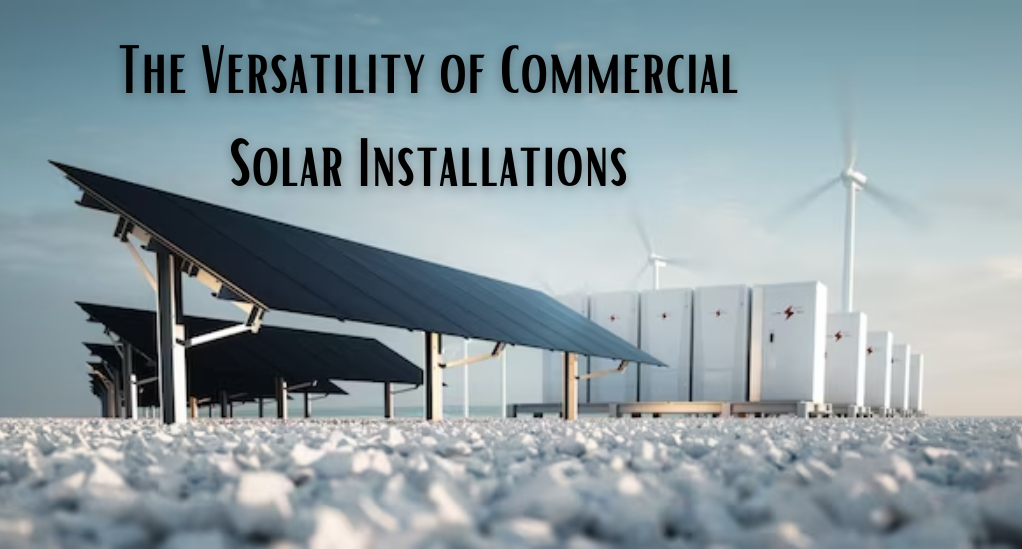In recent years, the world has witnessed a significant uptick in the adoption of solar energy, with commercial sectors leading the charge. This surge can be attributed to a combination of factors: the declining costs of solar panels, heightened awareness about environmental sustainability, and the undeniable economic benefits of harnessing solar power.
Commercial solar installations, in particular, have become a focal point for businesses worldwide. As of 2021, the global installed capacity for commercial solar systems surpassed a remarkable milestone, indicating a clear shift towards renewable energy sources in the business realm.
Understanding the different types of solar installations available is crucial for any business considering this transition. Each installation type, be it rooftop arrays, ground-mounted systems, or innovative solar carports, offers unique advantages tailored to specific business needs and spatial constraints. For instance, while rooftop arrays are ideal for businesses with limited ground space, ground-mounted systems cater to those with expansive land areas.
| Installation Type | Ideal For | Primary Advantage |
|---|---|---|
| Rooftop Arrays | Businesses with limited ground space | Maximizes existing space |
| Ground-Mounted Systems | Businesses with ample land | Flexibility in installation & expansion |
| Solar Carports | Businesses with parking areas | Dual functionality (parking & energy) |
Traditional Rooftop Arrays
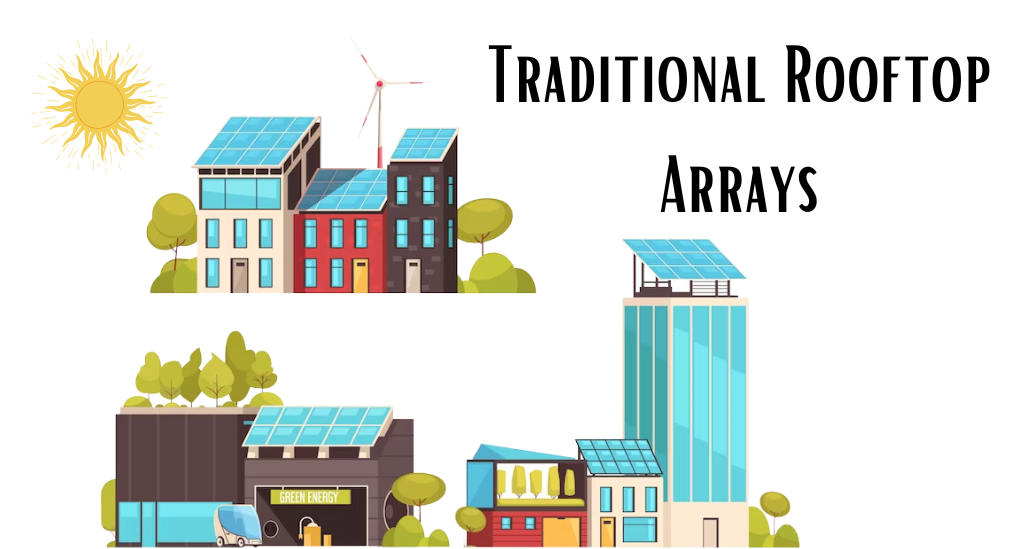
Rooftop solar installations have become a hallmark of urban sustainability, seamlessly integrating into the existing infrastructure of buildings. These installations consist of solar panels mounted on the roofs of commercial structures, capturing sunlight and converting it into electricity.
Benefits of Rooftop Solar Installations
- Space Efficiency: One of the primary advantages of rooftop arrays is their ability to utilize space that might otherwise go unused. Instead of requiring additional land, these systems take advantage of existing structures, making them particularly beneficial for urban areas where ground space is at a premium.
- Cost-Effective: By using existing infrastructure, businesses can often save on installation costs. There’s no need for additional land acquisition or extensive groundwork, which can be both time-consuming and expensive.
- Reduced Energy Bills: Once installed, rooftop solar panels can significantly reduce a business’s reliance on grid electricity. This not only leads to substantial savings on energy bills but also offers protection against fluctuating energy prices.
- Environmental Impact: By harnessing clean energy from the sun, businesses can reduce their carbon footprint, contributing to a reduction in greenhouse gas emissions. This not only benefits the environment but also enhances a company’s reputation as a green and responsible entity.
- Increased Property Value: Studies have shown that buildings equipped with solar installations often have higher property values compared to those without. This is due to the long-term energy savings and the modern, sustainable infrastructure that solar panels provide.
Innovative Solar Carports
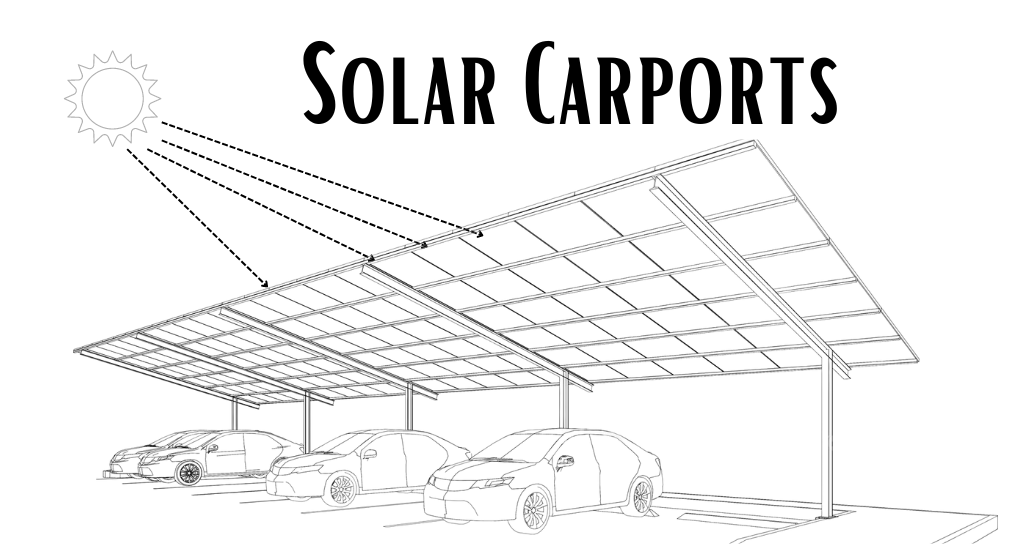
Solar carports, a groundbreaking advancement in the realm of renewable energy, are more than just shelters for vehicles. These structures, equipped with solar panels on their roofs, serve a dual purpose: providing shade for parked cars while simultaneously generating electricity.
Dual Functionality of Solar Carports
- Vehicle Protection: Just like traditional carports, solar carports offer protection against harsh weather conditions, be it scorching sun, rain, or snow. Vehicles parked underneath are shielded, which can prolong the life of the vehicle’s paint and interior.
- Electricity Generation: The rooftop of the carport, fitted with solar panels, captures sunlight and converts it into electricity. This energy can be used to power the adjacent building, stored in batteries for later use, or even fed back into the grid.
Benefits for Businesses with Parking Lots or Open Spaces
- Optimized Use of Space: For businesses with expansive parking lots, solar carports turn these areas into power-generating hubs without compromising their primary function.
- Savings on Energy Bills: The electricity generated can offset a significant portion of a business’s energy consumption, leading to substantial savings.
- Sustainable Brand Image: Adopting solar carports showcases a business’s commitment to sustainability, enhancing its reputation among eco-conscious consumers.
- Potential for EV Charging: With the rise of electric vehicles, solar carports can be equipped with EV charging stations, using the generated solar power to charge cars, making the business more attractive to EV owners.
Ground-Mounted Solar Panels
Ground-mounted solar panels, as the name suggests, are solar systems installed directly on the ground rather than on rooftops. These installations are especially suitable for businesses with abundant land, offering a scalable solution to meet their energy needs.
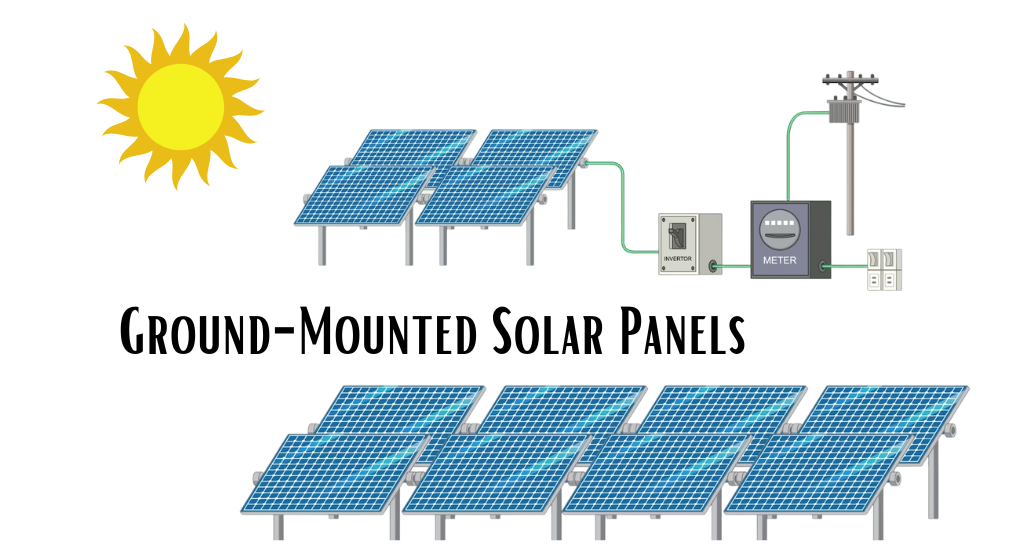
Key Features of Ground-Mounted Systems
- Installation: Unlike rooftop systems, ground-mounted panels aren’t constrained by roof size, shape, or material. They can be installed on virtually any terrain, be it flat or sloping.
- Orientation and Tilt: These systems can be optimally oriented and tilted to maximize sun exposure, ensuring optimal energy capture regardless of the site’s geographical location.
Advantages for Businesses with Ample Land
- Scalability: One of the standout benefits is the ability to scale. Businesses can start with a smaller installation and expand as their energy needs grow, without the limitations of roof space.
- Maintenance: Ground-level installations are generally easier to access and maintain. Cleaning, repairs, and system checks can be conducted with greater ease compared to rooftop systems.
- Cooling: Being on the ground, these panels often have better airflow beneath them, which can help in cooling and potentially increase their efficiency.
- Customization: Ground-mounted systems can be tailored to specific energy needs, with the flexibility to add more panels, integrate storage solutions, or even incorporate tracking systems that follow the sun’s movement.
Flexibility in Installation and Expansion
Businesses can strategically plan their installations based on current and projected energy needs. The expansiveness of the land allows for phased installations, ensuring that businesses can adapt to changing energy demands without significant infrastructural changes.
Ground-mounted solar panels offer businesses a versatile and efficient energy solution. With the freedom to optimize, expand, and customize, these systems are a testament to the adaptability of solar energy, especially for businesses blessed with abundant land.
The Power Tower Concept
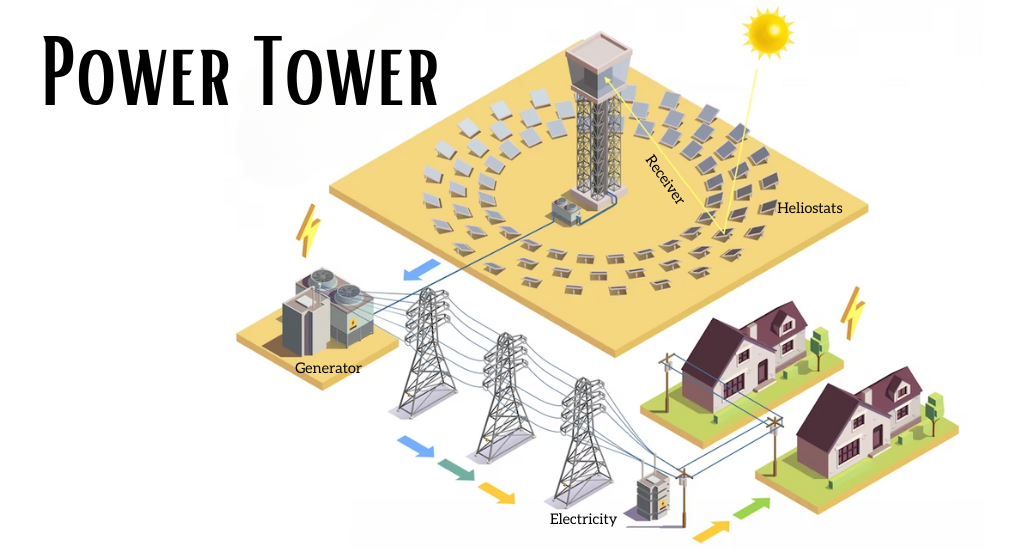
The “power tower,” also known as a solar tower or central receiver system, represents a cutting-edge approach to harnessing solar energy. Unlike traditional photovoltaic panels that directly convert sunlight into electricity, the power tower system focuses sunlight onto a central receiver using a field of mirrors.
Unique Design of the Power Tower
- Central Receiver: Positioned atop a tall tower, the central receiver collects the concentrated sunlight. This intense heat is then used to produce steam from water or another fluid.
- Heliostats: Surrounding the tower is an array of large, flat mirrors called heliostats. These mirrors track the sun’s movement and reflect its rays onto the central receiver, ensuring maximum sunlight concentration throughout the day.
Maximizing Solar Energy Capture
- Concentration: By focusing sunlight from a vast area onto a single point, the power tower achieves temperatures high enough to generate steam at great pressures, driving turbines to produce electricity efficiently.
- Thermal Storage: One of the standout features of power towers is their ability to store heat. Using materials like molten salts, these systems can retain heat for hours, allowing electricity generation even after sunset.
- Optimized Tracking: The heliostats’ ability to track the sun’s movement ensures that the sunlight is consistently focused on the receiver, maximizing energy capture from dawn to dusk.
In essence, the power tower concept revolutionizes solar energy capture by combining concentration, storage, and tracking. This synergy ensures consistent and efficient energy production, making it a promising solution for regions with high solar insolation.
Tailoring Solar Systems to Business Needs
In the realm of solar energy, one size doesn’t fit all. Businesses, with their diverse operations and varying scales, require solar solutions that align perfectly with their unique energy needs and operational dynamics.
Customizing Installations Based on Business Type and Energy Requirements
- Business Type: A manufacturing unit with heavy machinery has different energy needs compared to a tech startup operating in a co-working space. The solar installation must be tailored to cater to these specific demands. For instance, a factory might benefit from a large ground-mounted system, while an urban office might opt for rooftop panels or solar carports.
- Energy Consumption Patterns: Retail businesses that operate mainly during daylight hours might prioritize direct solar energy utilization. In contrast, a 24/7 call center might benefit from integrating battery storage to utilize solar energy during nighttime operations.
The Imperative of a Thorough Energy Audit
- Understanding Energy Consumption: An energy audit delves deep into a business’s energy consumption patterns. It identifies peak consumption hours, energy-intensive operations, and potential areas for energy conservation.
- Optimizing System Size: Post audit, businesses can determine the optimal size of the solar installation. This ensures that the system neither underproduces nor overproduces energy, leading to cost-effective operations.
- Identifying Potential Savings: The audit can spotlight areas where energy is wasted, guiding businesses towards potential energy-saving measures, which, when combined with solar installations, can lead to significant cost reductions.
Solar installation to truly resonate with a business’s operational needs and financial objectives, it’s essential to tailor the system meticulously. This customization, underpinned by a comprehensive energy audit, ensures that businesses not only adopt solar energy but optimize its myriad benefits.
Commercial Solar Panel Installation Cost
The transition to solar energy is not just an environmental decision but also a financial one. For businesses, understanding the cost dynamics of solar installations is crucial to ensure a sound investment.
Breakdown of Costs Associated with Different Types of Installations
- Initial Setup Costs: This encompasses the price of solar panels, inverters, mounting equipment, and other essential components. The cost can vary based on the type of installation. For instance, ground-mounted systems might require additional civil work, while rooftop installations might need structural reinforcements.
- Labor and Installation: The complexity of the installation, site accessibility, and local labor rates can influence this cost component.
- Maintenance and Upkeep: While solar panels have minimal maintenance needs, periodic checks, cleaning, and potential component replacements should be factored into the long-term cost.
| Installation Type | Initial Setup | Labor & Installation | Maintenance |
|---|---|---|---|
| Rooftop Arrays | Medium | Medium-High | Low |
| Ground-Mounted | High | High | Medium |
| Solar Carports | Medium-High | Medium | Low |
ROI and the Role of Incentives and Tax Breaks
- Return on Investment (ROI): The ROI is influenced by energy savings, reduced utility bills, and potential revenue from feeding excess energy back into the grid. Typically, businesses can expect a payback period of 3-7 years, depending on the installation size and local energy rates.
- Incentives and Tax Breaks: Many governments and local authorities offer incentives to promote solar adoption. This can be in the form of upfront rebates, tax credits, or feed-in tariffs. Such incentives can significantly reduce the effective installation cost and hasten the ROI.
In essence, while the initial investment in solar might seem substantial, the combination of long-term savings, incentives, and the tangible benefits of sustainable energy often makes it a financially astute decision for businesses.
Conclusion
The journey through the multifaceted world of commercial solar installations reveals a clear narrative: solar energy is not just a fleeting trend but a transformative force reshaping the business landscape. As we’ve delved into the various installation types, from the ubiquity of rooftop arrays to the innovation of power towers, it’s evident that solar technology offers solutions tailored for diverse business needs.
Examining the various solar installation types reveals distinct advantages tailored to specific scenarios. Rooftop arrays are ideal for urban businesses, maximizing space utilization. Ground-mounted systems, suited for entities with extensive land, offer scalability and customization. Solar carports, designed for businesses with parking spaces, provide dual benefits of shade and electricity generation. Meanwhile, power towers cater to large-scale energy producers, emphasizing high efficiency and consistent power output. Each type ensures a tailored solar solution for diverse business needs.
Beyond the technicalities, the financial implications, from installation costs to ROI, emphasize that solar is a sound investment. With governmental incentives and the global push for sustainability, businesses stand at a pivotal juncture.
In wrapping up, the transition to solar is not just about harnessing energy from the sun. It’s a statement, a commitment to sustainability, and a forward-looking approach that aligns business growth with planetary well-being. As the sun sets on conventional energy sources, the dawn of a solar-powered future beckons, promising a brighter, greener, and more sustainable tomorrow for businesses worldwide.

